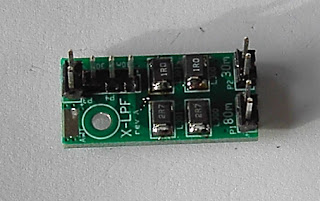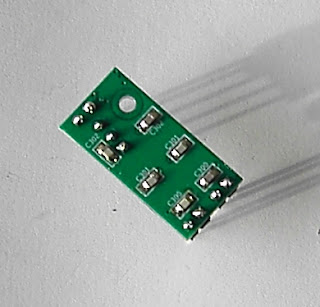Here's the softrock 6.3, built for installation in the SDR cube, with the plug in RX (receive) amplifier board installed (the one with the white rectangular relays on it), and with the TX (transmit) power amplifier (PA) board plugged in (the one with the black heatsinks).
Different amateur or shortwave bands occupy different parts of the spectrum, and the receive circuitry and transmit circuitry need to be fine tuned for those frequencies. The softrock design is modular and allows TXPA and RX amplifier modules to be built and plugged in for the particular band being used, in this case, the 80m band. The 80m band is not too far above the AM broadcast band, around the 3.5-3.7MHz portion of the dial, and like AM radio stations, improves at night.
The LPF board was built next, here's the top, followed by the underside. The LPF board jumpers provide selectable low pass filtering of harmonics when transmitting on various bands.
The next step was installation of the aluminium sub chassis to which the IO board and softrock attach. The already built and tested digital components are on the right of the enclosure.
Next is the wiring up of the DSP sub board:
Which then has its cables fed through the relevant bits of the chassis to get to the softrock
The IO board has already been attached to the sub chassis, along with the display board with the LCD and controls. Note the cable tie securing the high efficiency switch mode regulator to the sub chassis:
Next is the installation of the DSP board, the softrock, the LPF board, and finally, the attachment of the various cables:
And then putting the lid on the unit.
After assembly, the I/Q receive and transmit balance is adjusted to optimize opposite sideband suppression, output power is set to about 800mW, and the DDS is fine tuned using a known frequency, in this case, I used an AM broadcast station.
The software was also upgraded over the serial port enabling updated firmware to be installed with support for WSPR beaconing.
http://wsprnet.org/
The WSPR beacon code was added to the SDR Cube firmware by Roland Etienne F8CHK.
This is the beauty of open source and open hardware projects. You can add whatever features you like because the code and design is open, and anyone in the world can join in.
I need to resist the urge to code tetris to run on it... a morse code practice module would be more practical....
Here it is, receiving an AM broadcast station on upper sideband. The software is "adding the carrier" and then performing "detection" to demodulate the audio, ending up with same outcome as a BFO (beat frequency oscillator) and detector (i.e. a diode or a cat's whisker in a crystal set) would in an analogue receiver.
This demonstrates nicely how all the information needed to transmit information (voice in this case) can be contained in just one sideband, with the carrier and the opposite sideband being basically redundant and a waste of transmitter power.










Wow what a great blog, i really enjoyed reading this, good luck in your work. Roller Blinds
ReplyDeletehttps://supply.ctdi.com/shop/productdetail/305436/system-control-prncd
ReplyDelete